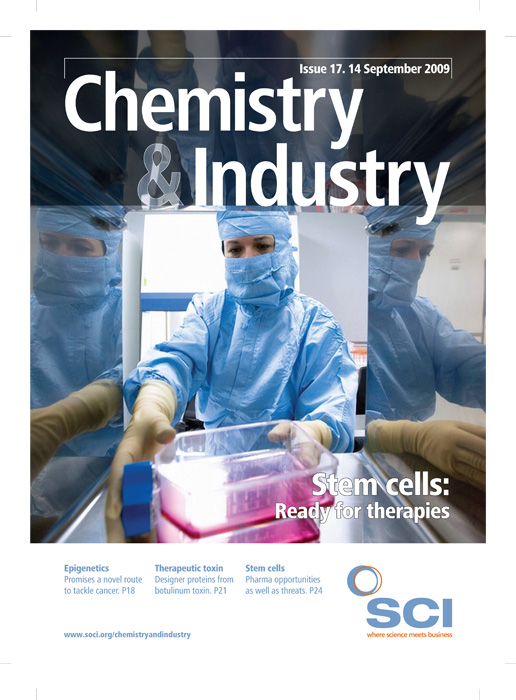Stem cells have been making a lot of headlines in
the past few months. However, stem-cell based
therapies really aren’t all that new, according to
Brendon Noble, a stem cell expert at the University
of Edinburgh’s new MRC Centre for Regenerative
Medicine (CRM). As a former drug discovery scientist,
Noble recalls: ‘I didn’t call myself a stem cell biologist
or anything but we were working on compounds
that make bones mend and 70% of the time what
we were doing was tapping into stem cells that were
already in all of us and can make more bone form. So
we’ve been doing this for a long time in the body.’
Today, Noble’s research at Edinburgh involves a
different strategy: this time, taking stem cells outside
of the body and growing them on scaffolds before
putting them back into animal models. Ultimately, the
goal is to use the cells to repair cartilage and so help
to prevent and even cure osteoarthritis, which is the
fourth biggest reason for disability in the EU, Noble
points out. ‘Cartilage is the body’s shock absorber
to stop us hurting every time we move,’ he explains;
unlike bone, it can’t repair itself after injury.
By curing diseases that would otherwise often
be treated with traditional small molecule drugs,
stem cell therapies threaten ultimately to wipe
out swathes of existing pharma revenue streams.
However, they also promise a new technology
platform that could help to offset losses from patent
expiries and dwindling drug pipelines. According
to Insight Pharma, stem cell therapies are currently
in development for Alzheimer’s disease (26.6m
potential patients worldwide), cancer (20m new
patients/year), cardiovascular disease (38m), diabetes
mellitus (177m), Parkinson’s disease (6m) and spinal
cord injury (2m). It cites Robin R. Young’s ‘oft-quoted
projection’ of an $8.5bn stem cell market by 2016.
‘The[ir] precise contribution remains to be
seen, but it is clear that stem cells will provide
major benefits,’ says Ian Wilmut, who heads up the
Edinburgh CRM: ‘In some cases, cells will replace
those in the patient which have died or stopped
functioning appropriately. In other diseases, stem
cells will be used to deliver biologically active
molecules to a specific location either to kill tumours
or to provide support for tissue that is damaged.’
The world’s first approved stem cell therapy,
meanwhile, could be on the marketplace as early
as next year. Osiris Therapeutics’ Prochymal has
already been fast-tracked by the US Food & Drug
Administration (FDA) for use in the treatment of
graft versus host disease – when the body rejects
foreign tissues during bone marrow transplantation
or after blood transfusion. Osiris plans to complete
submission for a Biologic License Application (BLA),
and says it will request a priority review for marketing
approval by the end of 2009.
‘Prochymal will be the first stem cell drug to
have gone through classical clinical trial pathway,
including pivotal studies,’ says chief scientific officer
Michelle Le Roux Williams. Like bone marrow
transplants, which have been successfully used in
the clinic since the 1960s, Prochymal uses adult
stem cells derived from bone marrow. However,
‘Prochymal is very different from a bone marrow
transplant,’ Le Roux says, as it comprises ‘a different
class of [mesenchymal] stem cells… that give rise
to tissues like bone and connective tissues.’ The
hematopoetic stem cells involved in bone marrow
transplants, by contrast, form red and while blood
cells and platelets, designed to rescue the patients
own blood forming system after chemo or radiation
therapy.
In addition, the Osiris cells are grown and cultured
in a GMP manufacturing process, Le Roux Williams
continues, quite different from the way that cells are
harvested for bone marrow transplants. As many as
10, 000 doses of Prochymal can be produced from a
single bone marrow donation.
However, stem cell therapies are not just about
using cells, but also about using molecules that
direct those cells to behave as researchers would
like, says Pfizer chief scientific officer Ruth McKernan.
'Stem cell therapy is all about controlling cell fate,'
McKernan explains. In nature, cells carry around with
them a complex but precise combination of growth
factors, peptides and other molecules, carefully
honed through many generations of evolution.
‘We can think of the cell as a drug delivery
device for a combination of growth factors, peptide
molecules that the body has optimised,’ McKernan says. ‘What happens in normal development is
stem cells make a variety of cell types, but in the lab
we can control cell fate by using traditional small
molecules.’





